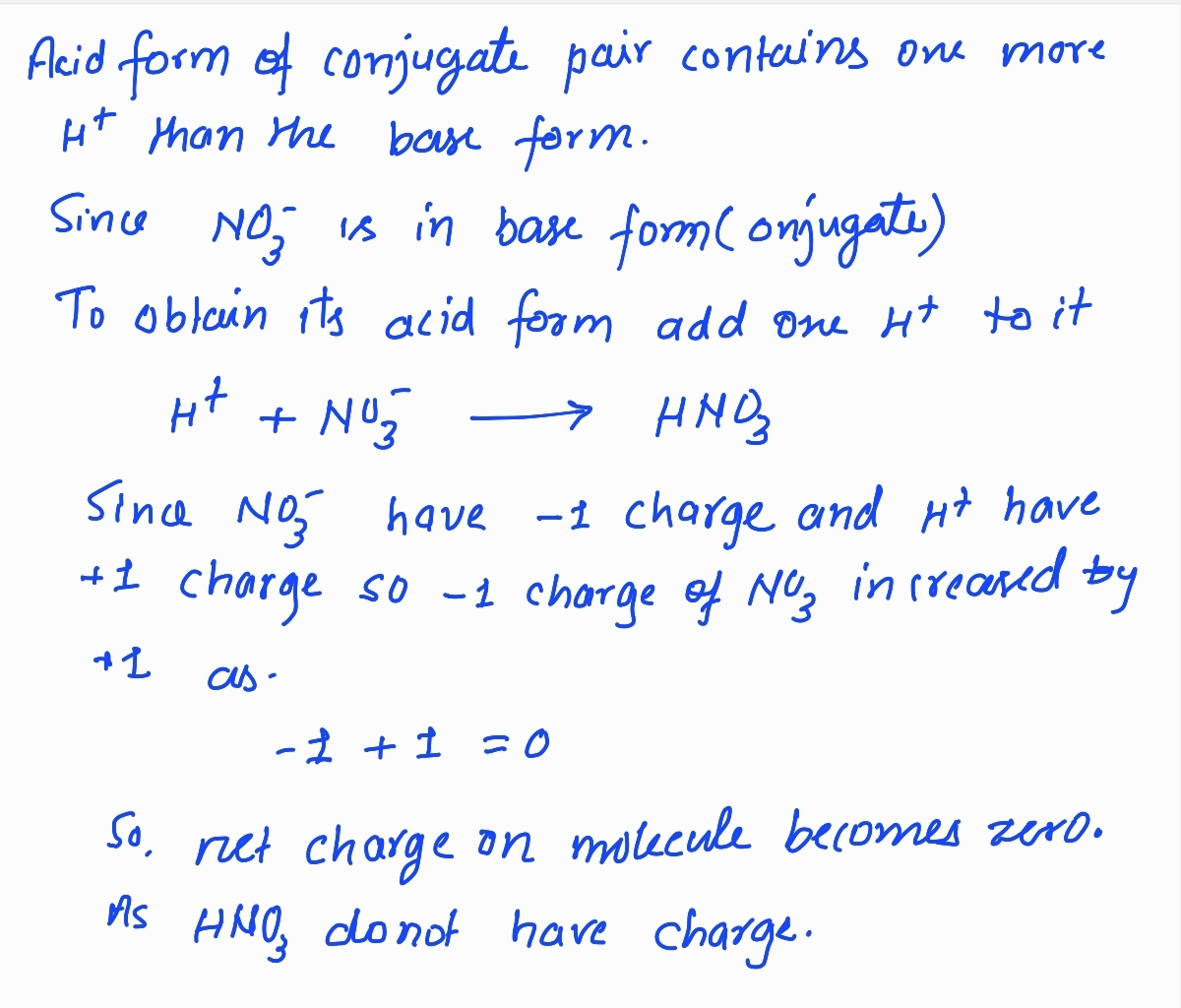8.15) What is the acid form of NO3-? Answer: HNO3 EXPLANATION: The acid form of a conjugate pair contains one more H+ than the base form. The acid form is obtained by adding an H+ to the base form. • Note that when an H+ is added to a species, its charge increases by one charge unit. NO3- has a 1- charge, however when an H+ is added, it is converted to HNO3; the charge increases by one charge unit. Conversely, the base form is obtained by removing an H+ from the acid form. Note that when an H+ is removed from a species, its charge decreases by one charge unit. ●
8.15) What is the acid form of NO3-? Answer: HNO3 EXPLANATION: The acid form of a conjugate pair contains one more H+ than the base form. The acid form is obtained by adding an H+ to the base form. • Note that when an H+ is added to a species, its charge increases by one charge unit. NO3- has a 1- charge, however when an H+ is added, it is converted to HNO3; the charge increases by one charge unit. Conversely, the base form is obtained by removing an H+ from the acid form. Note that when an H+ is removed from a species, its charge decreases by one charge unit. ●
Chemistry
10th Edition
ISBN:9781305957404
Author:Steven S. Zumdahl, Susan A. Zumdahl, Donald J. DeCoste
Publisher:Steven S. Zumdahl, Susan A. Zumdahl, Donald J. DeCoste
Chapter1: Chemical Foundations
Section: Chapter Questions
Problem 1RQ: Define and explain the differences between the following terms. a. law and theory b. theory and...
Related questions
Question
100%
I need help with this question. Can you help me to show the work like step by step

Transcribed Image Text:8.15) What is the acid form of NO3-?
Answer: HNO3
EXPLANATION:
The acid form of a conjugate pair contains one more H+ than the base form.
The acid form is obtained by adding an H* to the base form.
●
• Note that when an H+ is added to a species, its charge increases by one charge
unit. NO3- has a 1- charge, however when an H+ is added, it is converted to
HNO3; the charge increases by one charge unit.
Conversely, the base form is obtained by removing an H+ from the acid form.
Note that when an H+ is removed from a species, its charge decreases by one
charge unit.
●
Expert Solution
Step 1

Step by step
Solved in 2 steps with 1 images

Knowledge Booster
Learn more about
Need a deep-dive on the concept behind this application? Look no further. Learn more about this topic, chemistry and related others by exploring similar questions and additional content below.Recommended textbooks for you

Chemistry
Chemistry
ISBN:
9781305957404
Author:
Steven S. Zumdahl, Susan A. Zumdahl, Donald J. DeCoste
Publisher:
Cengage Learning

Chemistry
Chemistry
ISBN:
9781259911156
Author:
Raymond Chang Dr., Jason Overby Professor
Publisher:
McGraw-Hill Education

Principles of Instrumental Analysis
Chemistry
ISBN:
9781305577213
Author:
Douglas A. Skoog, F. James Holler, Stanley R. Crouch
Publisher:
Cengage Learning

Chemistry
Chemistry
ISBN:
9781305957404
Author:
Steven S. Zumdahl, Susan A. Zumdahl, Donald J. DeCoste
Publisher:
Cengage Learning

Chemistry
Chemistry
ISBN:
9781259911156
Author:
Raymond Chang Dr., Jason Overby Professor
Publisher:
McGraw-Hill Education

Principles of Instrumental Analysis
Chemistry
ISBN:
9781305577213
Author:
Douglas A. Skoog, F. James Holler, Stanley R. Crouch
Publisher:
Cengage Learning

Organic Chemistry
Chemistry
ISBN:
9780078021558
Author:
Janice Gorzynski Smith Dr.
Publisher:
McGraw-Hill Education

Chemistry: Principles and Reactions
Chemistry
ISBN:
9781305079373
Author:
William L. Masterton, Cecile N. Hurley
Publisher:
Cengage Learning

Elementary Principles of Chemical Processes, Bind…
Chemistry
ISBN:
9781118431221
Author:
Richard M. Felder, Ronald W. Rousseau, Lisa G. Bullard
Publisher:
WILEY